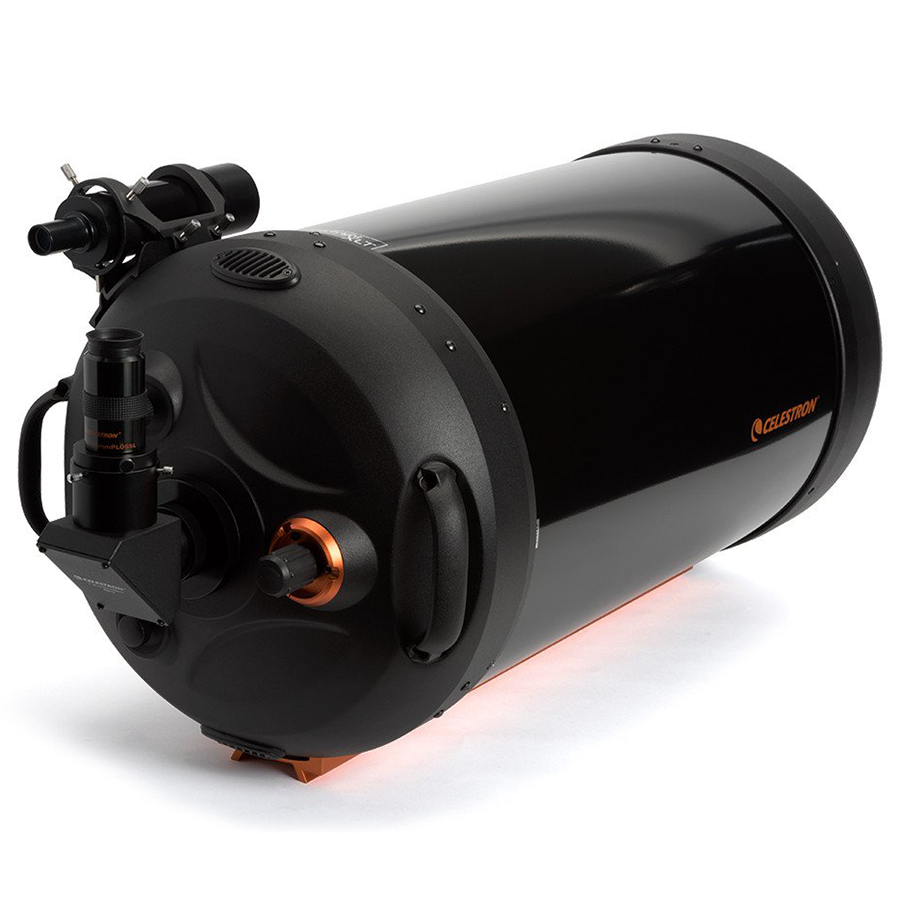14" SCT Optical Tube Assembly (CGE)
14" SCT Optical Tube Assembly (CGE)
14" Schmidt-Cassegrain Optical Tube Assembly (OTA)
Overview:
The Celestron C14-AF XLT optical tube is a world-class instrument that delivers a level of detail to all your favorite deep sky objects. This observatory-ready instrument the largest in its class with over three times the light gathering power of an 8" telescope. With this OTA, you can see amazing detail on the surface of Jupiter, resolve details on the surface of Mars, see Cassini's Division in the rings of Saturn, and even the distant planets of Uranus and Neptune.
The C14 packs serious light gathering ability into its durable aluminum optical tube. It’s an ideal instrument for serious astrophotography, providing high-contrast views even at very high magnifications. It is equipped with Celestron’s patented StarBright® XLT optical coatings, which visibly increase contrast and light transmission for brighter deep space images and shorter exposure times.
The tube offers a focal ratio of f/11 with the added versatility of Fastar (see below). You can also pair it with the f/6.3 focal reducer for even more astroimaging options.
This flagship OTA can be mounted on a multitude of computerized telescope mounts thanks to its CGEM-style dovetail bar. It’s sure to take your visual observing and imaging to the next level.
Fastar Technology
In 1997, CCDs were making a name for themselves in the astrophotography world, quickly supplanting traditional film photography thanks to their speed and convenience. This was the year that Celestron joined forces with the Santa Barbara Instruments Group (SBIG) to produce Fastar, a revolutionary add-on to Celestron’s hugely popular Schmidt-Cassegrain (SCT) optical system.
With Fastar, the SCT’s secondary mirror can be removed and replaced with a field-flattening lens assembly (sold separately by third party manufacturers) so that a CCD camera can be used in the front of the telescope at the f/2 focus of the instrument’s primary mirror. The potential of the Fastar system is staggering: exposures are 25 times shorter than if the camera was placed at the instrument’s native f/10 focus. Imagers can capture galaxies and nebulae with exposures of just 30 seconds.
StarBright XLT Coatings
StarBright XLT is Celestron’s revolutionary optical coating system. It consistently outperforms all other coatings in the commercial telescope market. There are three major components that make up our StarBright XLT high-transmission optical system design:
- Unique enhanced multi-layer mirror coatings made from precise layers of aluminum, SiO2 (quartz), TiO2 (titanium dioxide), and SiO2 (silicon dioxide). Reflectivity is fairly flat across the spectrum, optimizing it for both imaging and visual observing.
- Multi-layer anti-reflective coatings made from precise layers of MgF2 (magnesium fluoride) and HfO2 (hafnium dioxide). Hafnium—a rare element that costs nearly $2,000 per kilogram—gives us a wider band pass than the titanium used in competing coatings.
- High-transmission water white glass is used instead of soda lime glass for the corrector lens. Water white glass transmits about 90.5% of light without anti-reflective coatings; that’s 3.5% better than uncoated soda lime glass. When water white glass is used in conjunction with StarBright XLT’s anti-reflective coatings, the average transmission reaches an astonishing 97.4.
These three components make StarBright XLT one of the finest coatings available.
Features:
- 14" Schmidt-Cassegrain optical tube assembly (OTA)
- Features Celestron's premium patented StarBright XLT optical coatings
- 3910mm focal length (f/11)
- Fastar compatible
- Tube constructed of durable and lightweight aluminum
- Includes: 40mm eyepiece (98x), 9x50 optical finderscope, 2" star diagonal, 2” visual back, CGEM-style dovetail bar
Includes These Celestron Technologies
 |
Fastar Technology allows imagers the option of drastically increasing the speed and sensitivity of their Celestron optical tube, allowing bright, detailed images with short exposures. |
 |
One of the most important factors in a telescope is its transmission—the percentage of light that reaches the focal plane. Our proprietary StarBright XLT optical coatings dramatically increase transmission, up to 97.4% on our Schmidt corrector lenses. |
| Optical Design: | Schmidt-Cassegrain |
| Aperture: | 355.5mm (14") |
| Focal Length: | 3910mm (154") |
| Focal Ratio: | f/11 |
| Focal Length of Eyepiece 1: | 40mm (1.57") |
| Magnification of Eyepiece 1: | 98x |
| Finderscope: | 9x50 |
| Star Diagonal: | 2" with 1.25" adapter |
| Optical Tube: | Aluminum |
| Highest Useful Magnification: | 840x |
| Lowest Useful Magnification: | 51x |
| Limiting Stellar Magnitude: | 15.3 |
| Resolution (Rayleigh): | 0.39 arc seconds |
| Resolution (Dawes): | 0.33 arc seconds |
| Light Gathering Power: | 2581x (Compared to human eye) |
| Secondary Mirror Obstruction: | 114mm (4.5") |
| Secondary Mirror Obstruction by Diameter: | 32% |
| Secondary Mirror Obstruction by Area: | 10% |
| Optical Coatings: | StarBright XLT |
| Optical Tube Length: | 787mm (31") |
| Optical Tube Diameter: | 400.5mm (15.77") |
| Optical Tube Weight: | 46 lbs (21 kg) |
| Dovetail: | CGE Dovetail Bar |
| Solar Warning: |
|





- Choosing a selection results in a full page refresh.
- Opens in a new window.






